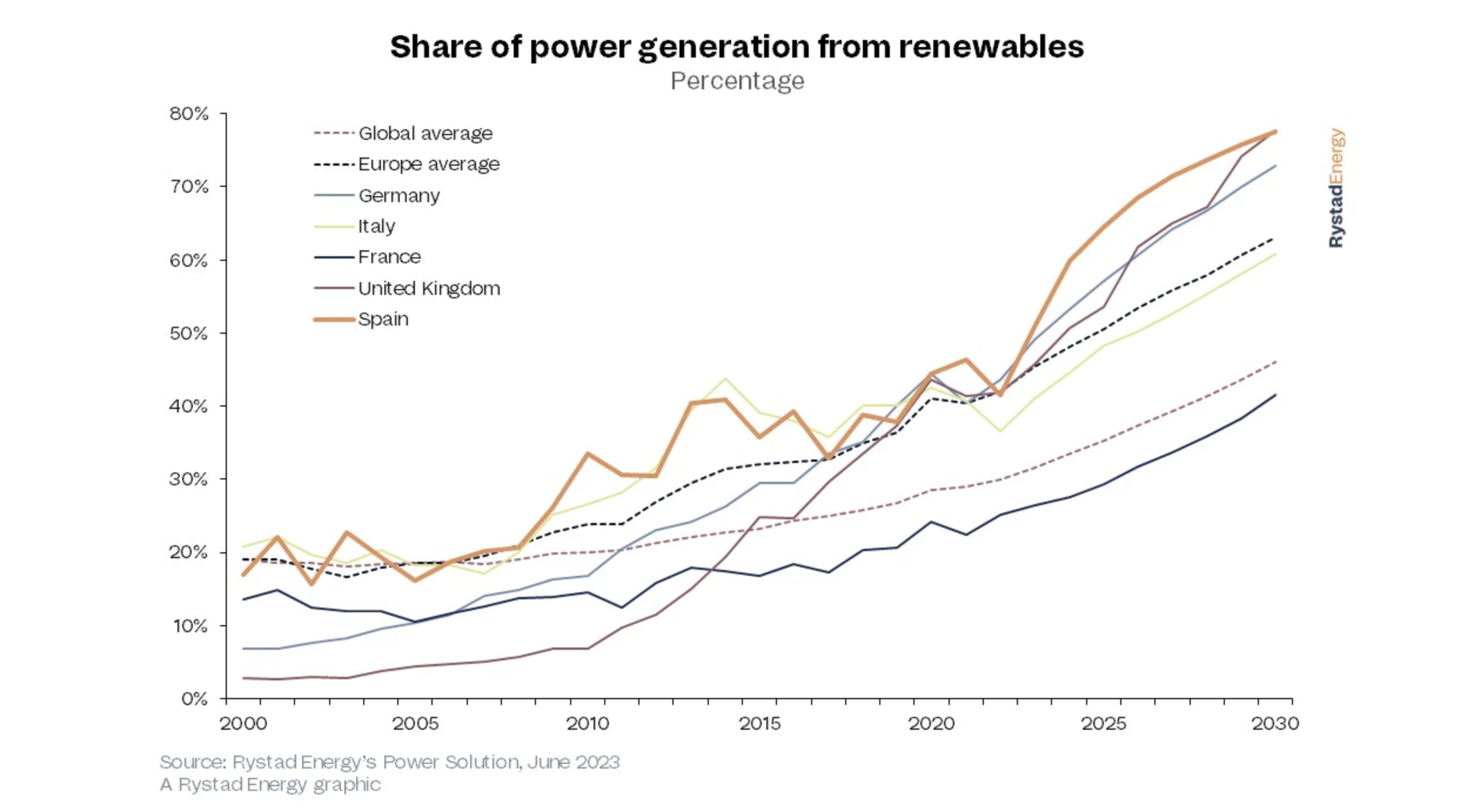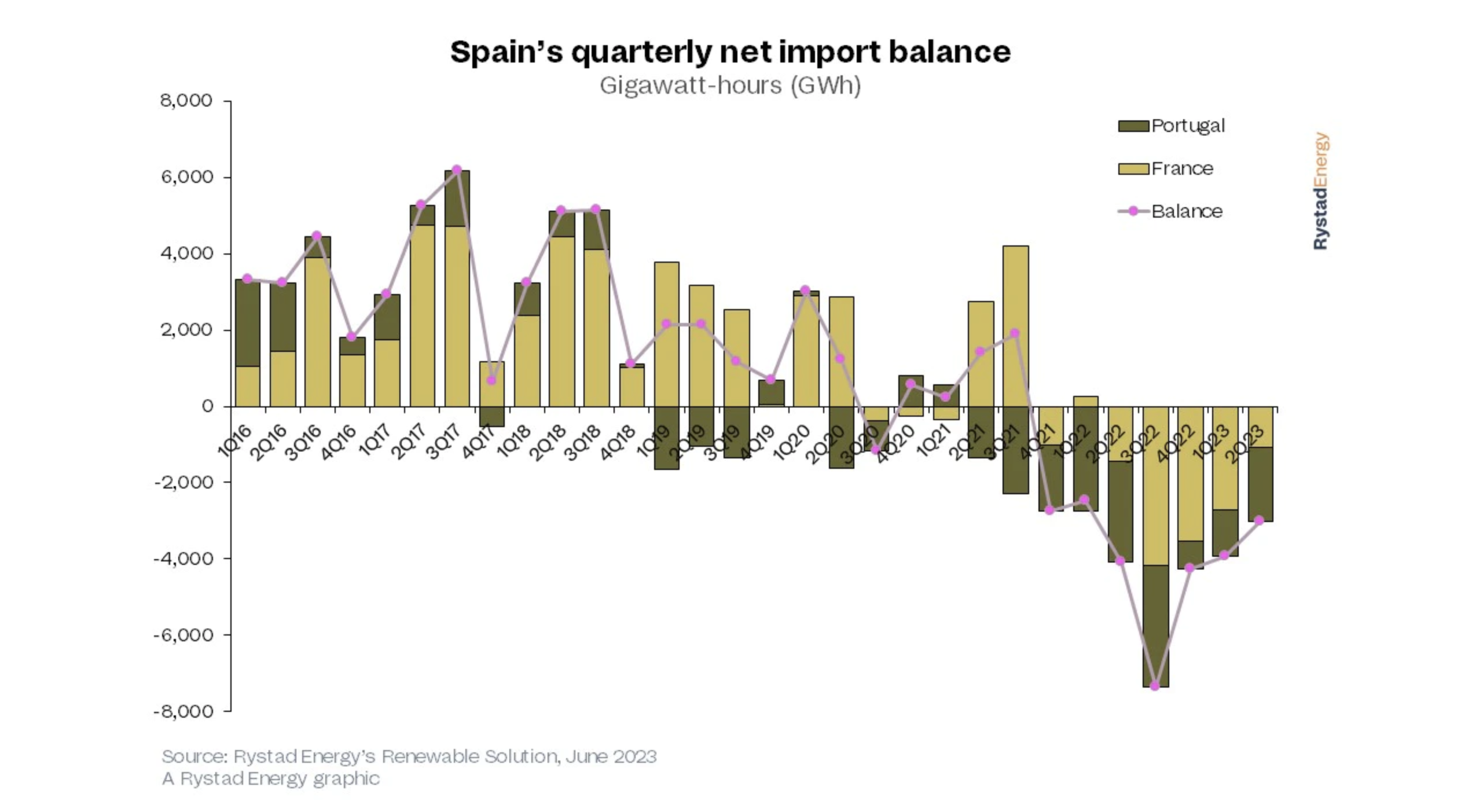
Spain is on track to surpass the notable mark of 50% renewable electricity in 2023, according to a recent report from Rystad Energy. In other words, more than half of Spain’s electricity is expected to come from renewable energy sources this year.
Spain is one of the five largest countries in Europe in terms of annual electricity demand. The others are Germany, France, Italy, and the UK (yes, the UK counts as part of Europe in this case). Spain is going to be the first of these five energy-consumption giants to pass the 50% marker. (It’s a bit ironic since Germany has gotten so much more attention for its renewable energy leadership.)
Funny enough, Spain already won our Cleantech Leader of the Week recognition this week. We can tag this news onto the rationale for it getting that award. The specific reason for that award this week was that I discovered Spain was the world leader in percentage of electricity coming from solar — nearly 20%. So, it’s not surprising to see that Spain is on the verge of cementing its renewable energy leadership in another way.
Rystad Energy has more to say: “Spain has been one of the long-time leaders in the European renewables sector, making substantial investments in solar and wind capacity over the last 10 years. In particular, the country was an early adopter of onshore wind, technology that now accounts for more than 20% of Spain’s power generation. Significant solar PV investments have also ramped up capacity and related generation in recent years. Hydropower, which used to be Spain’s largest source of renewable energy, accounts for approximately 10% of its total generation today.”
Notably, Spain’s nuclear-heavy neighbor to the north, France, has struggled a bit with that reliance, especially as time marches on, and Spain has thus had to export more electricity to France. Ironically, that could be a factor that limits the country’s own share of its electricity coming from renewables.
“While official data from the Spanish transmission system operator confirms more than 50% renewable power generation, power exports to France could disrupt further growth in 2023,” Rystad Energy states. “Market fundamentals have created a disparity between Spain and France, causing an increase in exports from the Iberian country to its northern neighbor. France has struggled with low nuclear power generation this year, forcing it to turn to Spain for power imports. Spain’s gradual transition from a net importer to a net exporter of power not only signifies the nation’s growing prominence in the European energy landscape but also underscores its journey towards becoming a key player in the global energy market. Thanks to an increasing share of electricity coming from renewables, lowered spot prices on average have been a stark contrast to higher spot prices in France.
“Spain’s prices have been significantly lower than France’s this year. Average power prices in France have been 34% higher than those in Spain, owing to various factors, including Spain’s transition from being one of Europe’s highest-priced spot markets to one of its lowest. Even when accounting for the effects of market intervention measures in 2022, the price disparity between Spain and France remains vast.”
So, all that fear mongering about how renewable energy would drive up prices or lead to a need for more energy imports — well, the opposite has been true. Spain is demonstrating that more electricity from renewables means lower prices and more energy stability.
Related story: Spain & Donald Trump: Cleantech Leader & Laggard Of The Week
Base of featured image by Kate Stejskal from Pixabay.
Sign up for daily news updates from CleanTechnica on email. Or follow us on Google News!
Have a tip for CleanTechnica, want to advertise, or want to suggest a guest for our CleanTech Talk podcast? Contact us here.
Former Tesla Battery Expert Leading Lyten Into New Lithium-Sulfur Battery Era — Podcast:
I don’t like paywalls. You don’t like paywalls. Who likes paywalls? Here at CleanTechnica, we implemented a limited paywall for a while, but it always felt wrong — and it was always tough to decide what we should put behind there. In theory, your most exclusive and best content goes behind a paywall. But then fewer people read it! We just don’t like paywalls, and so we’ve decided to ditch ours. Unfortunately, the media business is still a tough, cut-throat business with tiny margins. It’s a never-ending Olympic challenge to stay above water or even perhaps — gasp — grow. So …






